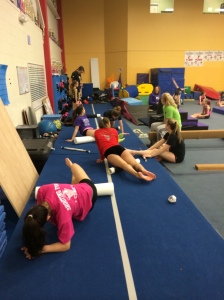There are certain areas that gymnasts can develop tightness and stiffness in, due to the nature of the sport, how we train, and other factors related to our daily movements. I know as soon as some people hear “gymnast” they assume the athlete has rubber band like mobility all over. Even though there are a lot of gymnasts who are pretty mobile, there are plenty of gymnasts who develop certain areas that tend to wind up. These same concepts also create excessive strain on other areas of the body that have to pick up the slack, often times becoming an area that breaks down and can become and injury. The lower back may be making up for tightness in the front of the hip during bridging skills, the shoulder may be making up for restricted extending movement in the middle spine during handstand work, and so on. Overtime if these areas are not addressed they can create large imbalances and compensations to occur, which can really throw off a gymnast’s mechanics.
































































